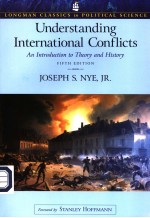

UNDERSTANDING INTERNATIONAL CONFLICTS AN INTRODUCTION TO THEORY AND HISTORY FIFTH EDITIONPDF电子书下载
- 电子书积分:11 积分如何计算积分?
- 作 者:OSEPH S.NYE
- 出 版 社:
- 出版年份:2222
- ISBN:0321209451
- 页数:276 页
CHAPTER I Is THERE AN ENDURING LOGIC OF CONlFLICT IN WORLD POULITICS? 1
What Is International Politics? 3
Two Views of Anarchic Politics 4
Building Blocks 8
The Peloponnesian War 12
A Short Version of a Long Story 13
Causes and Theories 15
Inevitability and the Shadow of the Future 17
Ethical Questions and International Politics 20
Limits on Ethics in International.Relations 22
Three Views of the Role of Morality 23
ChronOLOGY: Peloponnesian Wars 28
Study Questions 29
Notes 29
Selected Readings 30
Further Readings 30
CHAPTER 2 Origings of the of the Great Twentieth-Century Conflicts 33
International Systems and Levels of Causation 33
Levels of Analysis 35
Systems: Structure and Process 37
Revolutionary and Moderate Goals and Instruments 38
The Structure and Process of the Nineteenth. Century System 39
A Modem Sequel 42
Domestic Politics and Foreign Policy 43
Liberalism Revived 44
Liberal Democracy and War 47
Definition of National Interests 49
Variations in Foreign Policies 49
Counteffactuals 50
Plausibility 51
Proximity in Time 51
Relation to Theory 51
Facts 51
Chronologies: Europe 53
Study Questions 55
Notes 55
Selected Readings 55
Further Readings 56
CHAPTER 3 Balance of Power and World WAR I 58
Balance of Power 58
Power 59
Balances as Distributions of Power 62
Balance of Power as Policy 63
Balance of Power as Multipolar Systems 65
Alliances 67
The Origins of World War I 68
Three Levels of Analysis 69
Was War Inevitable? 74
What Kind of War? 77
The Funnel of Choices 79
Lessons of History Again 80
Chronology: The Road to World War I 81
Study Questions 82
Notes 82
Selected Readings 83
Further Readings 83
CHAPTER 4 THE FAILURE OF COLLECTIVE SECURITY AND WORLD WAR II 85
The Rise and Fall of Collective Security 85
The League of Nations 86
The United States and the League of Nations 88
The Early Days of the League 89
The Manchurian Failure 90
The Ethiopian Debacle 92
The Origins of World War II 93
Hitler's War? 94
Hitler's Strategy 95
The Role of the Individual 98
Systemic and Domestic Causes 99
Was War Inevitable? 102
The Pacific War 103
Appeasement and Two Types of War 107
Chronology: Between the World Wars 108
Study Questions 109
Notes 110
Selected Readings 110
Further Readings 110
CHAPTER 5 THE COLD WAR 112
Deterrence and Containment 113
Three Approaches to the Cold War 114
Roosevelt's Policies 116
Stalin's Policies 117
Phasesof the Conflict 118
Inevitability? 123
Levels of Analysis 124
U.S. and Soviet Goals in the Cold War 127
Containment 128
The Rest of the Cold War 129
The End of the Cold War 131
The Role of Nuclear Weapons 135
Physics and Politics 136
Balance of Terror 139
Problems of Nuclear Deterrence 140
The Cuban Missile Crisis 141
Moral Issues 143
Chronology: The Cold War Years 146
Study Questions 150
Notes 150
Selected Readings 151
Further Readings 151
CHAPTER 6 INTERVENTION, INSTITTUTIONS AND REGIONAL AND ETHNIC CONFLICTS 153
Ethnic Conflicts 154
Intervention and Sovereignty 155
Defining Intervention 158
Sovereignty 159
Judging Intervention 160
Exceptions to the Rule 161
Problems of Self. Determination 162
Motives, Means, and Consequences 164
International Law and Organization 166
Domestic Analogies 166
PredictabRiry and Legitimacy 168
The Suez Canal Crisis 169
U.N. Peacekeeping and Collective Security 171
Conflicts in the Middle East 174
The Questions of Nationalism 175
The Arab-Israeli Conflicts 178
The 1991 Gulf War and Its Aftermath 181
Chronology: The Arab-Israeli Conflict 186
Study questions 188
Notes 188
Selected Reodaings 188
Further geadings 189
CHAPTER 7 GLOnAUZATION AND INTERDEPENDENCE 191
The Dimensions of Globalization 192
What's New About Twenty-first Century Globalization? 194
Political Reactions to Globalization 196
Economic Interdependence and Conflict 197
The Concept of Interdependence 197
Sources of Interdependence 198
Benefits of Interdependence 199
Costs of Interdependence 200
Symmetry of Interdependence 202
Leadership irt the World Economy 205
Realism and Complex Interdependence 207
The Politics of Oil 208
Oil as a Power Resource 212
Study Questiohs 213
Notes 214
Selected Readings 214
Further Readings 214
CHAPTER 8 THE INFORMATION REVOLUTION, TRANSNATIONAL ACTORS, AND THE DIFFUSION OF POWER 217
Power and the Information Revolution 217
Lessons from the Past 218
A New World Politics? 220
Sovereignty and Control 221
Transnational Actors 225
Nongovernmental Organizations (NGOs) 228
Transnational Terrorism 229
Information and Power Among States 231
The Information Revolution and Complex Interdependence 233
The Information Revolution and Democratization 236
Study Questions 238
Notes 238
Selected Readings 239
Further Readings 239
CHAPTER 9 A NEw WORLD ORDER? 242
Alternative Designs for the Future 242
The End of History or the Clash of Civilizations? 247
Technology and the Diffusion of Power 249
Proliferation of Weapons of Mass Destruction 251
Transnational -Threats and the Concept of Security 253
A New World Order? 254
Future Configurations of Power 255
The Prison of Old Concepts 257
The Evolution of a Hybrid World Order 259
Thinking About the Future 260
Study Questions 261
Notes 261
Selected Readings 262
Further Readings 262
GLOSSARY 264
CREDITS 268
INDEX 269
